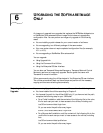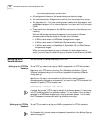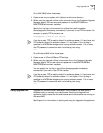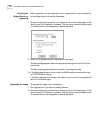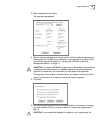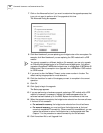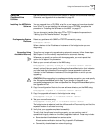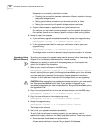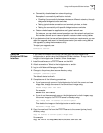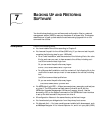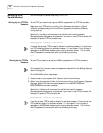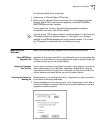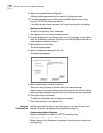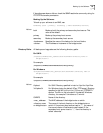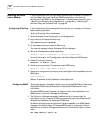
Using the Enterprise OS User Interface 59
■ Connectivity checks based on network topology.
Examples of a connectivity verification include:
■ Checking the connectivity between devices on different networks, through
designated bridge/routers or switches.
■ Testing typical device connections on terminals, printers, or hosts.
■ Testing the connectivity with specific bridge/routers or switches.
■ Custom checks based on applications and typical network use.
For instance, you can check normal operation over the network and perform
file transfers, as well as run traces on specific routes or check routing tables.
6 If you determine that the new software does not meet your requirements, you can
reject the upgrade, and revert to the software version you were running before
the upgrade, by using the bcmrestore utility.
To reject your upgrade, use:
bcmrestore <device>
Using the
Enterprise OS User
Interface
If you have not installed the utilities, you can copy the boot image to the
bridge/router or switch using the Enterprise OS user interface. To copy the boot
image to the bridge/router or switch, follow these steps:
1 Install the software on a FTP/TFTP server on the LAN.
2 Attach a console or Telnet to the bridge/router or switch.
3 Log in with Network Manager privilege.
4 Change to the primary boot source directory using:
ChangeDir [<device>:]<path>
The default device is drive A.
5 Complete one of the following procedures:
■ If you have enough room on the bridge/router for both the current and new
image files, change the name of the current boot image using:
ReName <image name> <new name>
For example:
ReName boot.68k oldboot
■ If you do not have enough room on the bridge/router for both images, copy
the current image to the FTP/TFTP server for backup using:
COpy <image name> <IP address of server>:<path/>
Then delete the image on the bridge/router or switch using:
RemoveFile <image name>
6 Copy the new boot file from the FTP/TFTP server to the current (primary boot)
directory using:
COpy <IP address of server>:<path/><image name>
For example:
COpy 129.142.10.10:image/NBSI/SW/110/CF/boot.68k boot.68k



